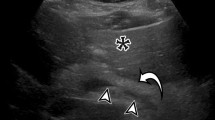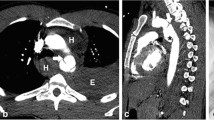Abstract
Background
The prompt detection and accurate localization of abdominal injuries are difficult. Some diagnostic modalities, including laboratory tests, ultrasound, and diagnostic peritoneal lavage (DPL) were used to evaluate patients with blunt abdominal trauma, with various advantages and pitfalls. We aimed to evaluate the risk and benefit of using multidetector computed tomography (MDCT) as an initial assessment tool for proper diagnosis and treatment planning of patients with blunt abdominal trauma.
Methods
Two hundred fifty-two patients with blunt abdominal trauma were prospectively enrolled. Multidetector computed tomography was performed during resuscitation. The risk and benefit of using MDCT in the diagnosis and planning of treatment were analyzed.
Results
The time required for a MDCT examination averaged 10.2 minutes. Of the studies done, 224 revealed abdominal injuries. Of those, 34 were performed in patients with unstable hemodynamic status without adverse effect. Prompt diagnosis and proper treatment were given according to the MDCT findings. A total of 43 (17.1%) MDCTs showed contrast extravasation. Active bleeding was confirmed in all and treated with transarterial embolization (30) or surgery (13). Another 58 patients sustained bowel, mesenteric, or pancreatic injuries (BMPI) necessitating laparotomy. The sensitivity, specificity, and accuracy of MDCT in identifying patients with active bleeding or BMPI were all 100%.
Conclusions
Multidetector computed tomography was useful as a second line initial assessment tool to identify injuries and determine treatment planning in blunt abdominal trauma patients. No increased risk was found if the facility is readily available, the protocol is well designed, and the patient is well prepared.




Similar content being viewed by others
References
Muckart DJ, Thomson SR. Undetected injuries: a preventable cause of increased morbidity and mortality. Am J Surg 1991;162:457–460
Rodriguez A, DuPriest RW Jr, Shatney CH. Recognition of intra-abdominal injury in blunt trauma victims—a prospective study comparing physical examination with peritoneal lavage. Am Surg 1982;48:457–459
Mackersie RC, Tiwary AD, Shackford SR, et al. Intra-abdominal injury following blunt trauma—identifying the high-risk patient using objective risk factors. Arch Surg 1989;124:809–813
Isaacman DJ, Scarfone RJ, Kost SI, et al. Utility of routine laboratory testing for detecting intra-abdominal injury in the pediatric trauma patient. Pediatrics 1993;92:691–694
Mendez C, Gubler KD, Maier RV. Diagnostic accuracy of peritoneal lavage in patients with pelvic fractures. Arch Surg 1994;129:477–481
Soderstrom CA, Dupriest RW Jr, Cowley RA. Pitfalls of peritoneal lavage in blunt abdominal trauma. Surg Gynecol Obstet 1980;151:513–518
Drost TF, Rosemurgy AS, Kearney RE, et al. Diagnostic peritoneal lavage. Limited indication due to evolving concepts in trauma care. Am Surg 1991;57:126–128
McKenney KL, McKenney MG, Cohn SM, et al. Hemoperitoneum score helps determine need for therapeutic laparotomy. J Trauma 2001;50:650–654
Partrick DA, Bensard DD, Moore EE, et al. Ultrasound is an effective triage tool to evaluate blunt abdominal trauma in the pediatric population. J Trauma 1998;45:57–63
Yoshii H, Sato M, Yamamoto S, et al. Usefulness and limitations of ultrasonography in the initial evaluation of blunt abdominal trauma. J Trauma 1998;45:45–50
Shanmuganathan K, Mirvis SE, Sherbourne CD, et al. Hemoperitoneum as the sole indicator of abdominal visceral injuries: a potential limitation of screening abdominal US for trauma. Radiology 1999;212:423–430
Federle MP, Crass RA, Jeffrey RB, et al. Computed tomography in blunt abdominal trauma. Arch Surg 1982;117:645–650
Wing VW, Federle MP, Morris JA Jr, et al. The clinical impact of CT for blunt abdominal trauma. AJR 1985;145:1191–1194
Pevec WC, Peitzman AB, Udekwu AO, et al. Computed tomography in the evaluation of blunt abdominal trauma. Surg Gynecol Obstet 1991;173:262–267
Richards JR, Derlet RW. Computed tomography for blunt abdominal trauma in the ED: a prospective study. Am J Emerg Med 1998;16:338–342
Foley WD, Cates JD, Kellman GM, et al. Treatment of blunt hepatic injuries: role of CT. Radiology 1987;164:635–638
Mirvis SE, Whitley NO, Vainwright JR, et al. Blunt hepatic trauma in adults: CT-based classification and correlation with prognosis and treatment. Radiology 1989;171:27–32
Fang JF, Chen RJ, Wong YC, et al. Classification and treatment of pooling of contrast material on computed tomographic scan of blunt hepatic trauma. J Trauma 2000;49:1083–1088
Poletti PA, Mirvis SE, Shanmuganathan K, et al. CT criteria for management of blunt liver trauma: correlation with angiographic and surgical findings. Radiology 2000;216:418–427
Kearney PA Jr, Vahey T, Burney RE, et al. Computed tomography and diagnostic peritoneal lavage in blunt abdominal trauma: their combined role. Arch Surg 1989;124:344–347
Sherck JP, Oakes DD. Intestinal injuries missed by computed tomography. J Trauma 1990;30:1–5
Amoroso TA. Evaluation of the patient with blunt abdominal trauma: an evidence based approach. Emerg Med Clin North Am 1999;17:63–75
Foley WD. Special focus session: multidetector CT: abdominal visceral imaging. Radiographics 2002;22:701–719
Killeen KL, Shanmuganathan K, Poletti PA, et al. Helical computed tomography of bowel and mesenteric injuries. J Trauma 2001;51:26–36
Pappas JN, Donnelly LF, Frush DP. Reduced frequency of sedation of young children with multisection helical CT. Radiology 2000;215:897–899
Novelline RA, Rhea JT, Rao PM, et al. Helical CT in emergency radiology. Radiology 1999;213:321–339
Pereira SJ, O’Brien DP, Luchette FA, et al. Dynamic helical computed tomography scan accurately detects hemorrhage in patients with pelvic fracture. Surgery 2000;128:678–685
Taylor GA, Kaufman RA, Sivit CJ. Active hemorrhage in children after thoracoabdominal trauma: clinical and CT features. AJR 1994;162:401–404
Willmann JK, Roos JE, Platz A, et al. Multidetector CT: detection of active hemorrhage in patients with blunt abdominal trauma. AJR 2002;179:437–444
Akhrass R, Kim K, Brandt C. Computed tomography: an unreliable indicator of pancreatic trauma. Am Surg 1996;62:647–651
Sivit CJ, Eichelberger MR, Taylor GA, et al. Blunt pancreatic trauma in children: CT diagnosis. AJR 1992;158:1097–1100
Fang JF, Chen RJ, Lin BC, et al. Small bowel perforation: is urgent surgery necessary? J Trauma 1999;47:515–520
Hawkins AE, Mirvis SE. Evaluation of bowel and mesenteric injury: role of multidetector CT. Abdom Imaging 2003;28:505–514
Brasel KJ, Borgstrom DC, Kolewe KA, et al. Abdominal computed tomography scan as a screening tool in blunt trauma. Surgery 1996;120:780–783
Eastridge BJ, Starr A, Minei JP, et al. The importance of fracture pattern in guiding therapeutic decision-making in patients with hemorrhagic shock and pelvic ring disruptions. J Trauma 2002;53:446–450
Giacomuzzi SM, Torbica P, Rieger M, et al. Radiation exposure in single slice and multi-slice spiral CT (a phantom study). Rofo: Fortschritte auf dem Gebiete der Rontgenstrahlen und der Nuklearmedizin 2001;173:643–649
Author information
Authors and Affiliations
Corresponding author
Rights and permissions
About this article
Cite this article
Fang, JF., Wong, YC., Lin, BC. et al. Usefulness of Multidetector Computed Tomography for the Initial Assessment of Blunt Abdominal Trauma Patients. World J. Surg. 30, 176–182 (2006). https://doi.org/10.1007/s00268-005-0194-7
Published:
Issue Date:
DOI: https://doi.org/10.1007/s00268-005-0194-7




